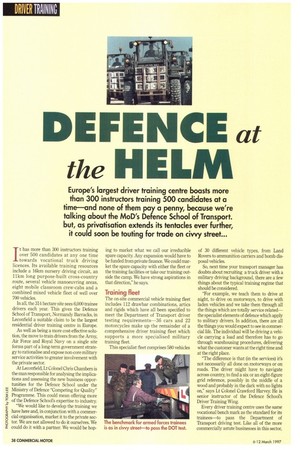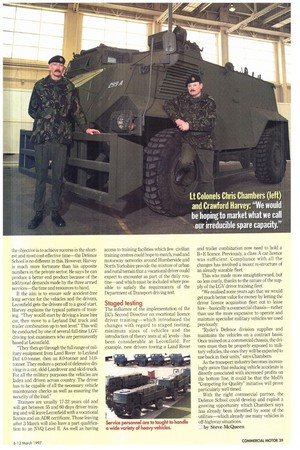NC
Page 40

Page 41

If you've noticed an error in this article please click here to report it so we can fix it.
the 111
LM
Europe's largest driver training centre boasts more than 300 instructors training 500 candidates at a time—and none of them pay a penny, because we're talking about the MoD's Defence School of Transport. but, as privatisation extends its tentacles ever further, it could soon be touting for trade on civvy street...
It has more than 300 instructors training over 500 candidates at any one time towards vocational truck driving licences. Its available training resources include a 16km nursery driving circuit, an 11km long purpose-built cross-country route, several vehicle manoeuvring areas, eight mobile classroom crew-cabs and a combined mixed vehicle fleet of well over 700 vehicles.
In all, the 314 hectare site sees 6,000 trainee drivers each year. This gives the Defence School of Transport, Normandy Barracks, in Leconfield a suitable claim to be the largest residential driver training centre in Europe.
As well as being a more cost-effective solution, the move to train drivers from the Army, Air Force and Royal Navy on a single site forms part of a long-term government strategy to rationalise and expose non-core military service activities to greater involvement with the private sector.
At Leconfield, Lt Colonel Chris Chambers is the man responsible for analysing the implications and assessing the new business opportunities for the Defence School under the Ministry of Defence "Competing for Quality" Programme. This could mean offering more of the Defence School's expertise to industry.
"We would like to develop the training we have here and, in conjunction with a commercial organisation, market it to the private sector. We are not allowed to do it ourselves. We could do it with a partner. We would be hop
ing to market what we call our irreducible spare capacity Any expansion would have to be funded from private finance. We could market the spare capacity with either the fleet or the training facilities or take our training outside the camp. We have strong aspirations in that direction," he says.
Training fleet
The on-site commercial vehicle training fleet includes 112 drawbar combinations, artics and rigids which have all been specified to meet the Department of Transport driver testing requirements-36 cars and 22 motorcycles make up the remainder of a comprehensive driver training fleet which supports a more specialised military training fleet This specialist fleet comprises 580 vehicles of 30 different vehicle types, from Land Rovers to ammunition carriers and bomb disposal vehicles.
So, next time your transport manager has doubts about recruiting a truck driver with a military driving background, there are a few things about the typical training regime that should be considered.
"For example, we teach them to drive at night, to drive on motorways, to drive with laden vehicles and we take them through all the things which are totally service related— the specialist elements of defence which apply to military drivers. In addition, there are all the things you would expect to see in commercial life. The individual will be driving a vehicle carrying a load and therefore has to go through warehousing procedures, delivering what the customer wants at the right time and at the right place.
"The difference is that (in the services) it not necessarily all done on motorways or on roads. The driver might have to navigate across country to find a six or an eight-figure grid reference, possibly in the middle of a wood and probably in the dark with no lights on," says Lt Colonel Crawford Harvey. He is senior instructor of the Defence School's Driver Training Wing Every driver training centre uses the same vocational bench mark as the standard for its trainees—to pass the Department of Transport driving test. Like all of the more commercially astute businesses in this sector, the objective is to achieve success in the shortest and most cost-effective time—the Defence School is no different in this. However, Harvey is much more fortunate than his opposite numbers in the private sector. He says he can produce a better end product because of the additional demands made by the three armed services—the time and resources to hand.
If the aim is to ensure safe accident-free long service for the vehicles and the drivers, Leconfield gets the drivers off to a good start. Harvey explains the typical pattern of training. "They would start by driving a lease hire car, then move to a Leyland Daf truck and trailer combination up to test level" This will be conducted by one of several full-time LGV driving test examiners who are permanently based at Leconfield.
"They then go through the full range of military equipment from Land Rover to Leyland Daf 4.0-tonner, then an 8.0-tonner and 14.0tonner. They endure a period of defensive driving in a car, skid-Landrover and skid-truck. For all the military purposes the vehicles are laden and driven across country. The driver has to be capable of all the necessary vehicle maintenance checks as well as ensuring the security of the load."
Trainees are usually 17-22 years old and will get between 55 and 60 days driver training and will leave Leconfield with a vocational licence and an ADR certificate. Those leaving after 3 March will also have a part qualification to an NVQ Level H. As well as having access to training facilities which few civilian training centres could hope to match, road and motorway networks around Humberside and North Yorkshire provide the mixture of urban and rural terrain that a vocational driver could expect to encounter as part of the daily routine—and which must be included where possible to satisfy the requirements of the Department of Transport driving test.
Staged testing
The influence of the implementation of the EC's Second Directive on vocational licence driver training—which introduced the changes with regard to staged testing, minimum sizes of vehicles and the introduction of theory tests at all levels—has been considerable at Leconfield. For example, new drivers towing a Land Rover and trailer combination now need to hold a B+E licence. Previously, a class A car licence was sufficient. Compliance with all the changes has involved a recent re-structure of an already sizeable fleet.
This was made more straightforward, but no less costly, thanks to the nature of the supply of the WV driver training fleet.
"We realised some years ago that we would get much better value for money by letting the driver licence acquisition fleet out to lease hire—basically a commercial chassis—rather than use the more expensive to operate and maintain specialist military vehicles we used previously.
'Ryder's Defence division supplies and maintains the vehicles on a contract basis. Once trained on a commercial chassis, the drivers must then be properly exposed to military vehicles, the ones they will be expected to use back in their units," says Chambers.
As the transport industry becomes increasingly aware that reducing vehicle accidents is directly associated with increased profits on the bottom line, it could be that the MoD's "Competing for Quality" initiative will prove particularly well timed.
With the right commercial partner, the Defence School could develop and exploit a growing opportunity which Chambers says has already been identified by some of the utilities—which already use many vehicles in off-highway situations.
III by Steve McQueen
































































































